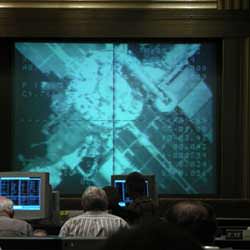
Ground controllers watching video of the final moments of docking. Image credit: Energia. Click to enlarge.
An unpiloted Russian cargo ship linked up to the International Space Station today to deliver more than two tons of food, fuel, oxygen, water, supplies and spare parts.
The ISS Progress 18 craft docked to the aft port of the Zvezda Service Module at 7:42 p.m. CDT as the Station flew 225 statute miles near Beijing, China. Within minutes, hooks and latches between the two ships engaged, forming a tight seal. The docking completed a two-day journey for the cargo ship since its liftoff Thursday from the Baikonur Cosmodrome in Kazakhstan.
As the Progress approached the Station, Expedition 11 Commander Sergei Krikalev had to take over manual control of the docking of the Progress due to a Russian ground station problem that prevented commands to be uplinked to the cargo ship for its final approach for an automated docking. Nonetheless, Krikalev executed a flawless linkup. NASA Flight Engineer and Science Officer John Phillips took video and still photos of the arrival.
The Progress is loaded with 397 pounds of propellant, 242 pounds of oxygen and air, 926 pounds of water and more than 3,000 pounds of spare parts, life support system components and experiment hardware. In addition, the Progress carries 40 new solid-fuel oxygen generating canisters as a supplemental source of oxygen, if required. The crew will open the Progress hatch later today but will not begin to unload the ship?s cargo until Sunday.
Among the items on the Progress is a new digital camera to be used by the Expedition 11 crew to capture images of the thermal protection system on the Shuttle Discovery during its approach to the Station during the STS-114 mission in July. The camera replaces a similar one that is no longer operable. The photos are part of the imagery-gathering effort to ensure that the Shuttle has no threatening damage to its heat shielding.
Information on the crew’s activities aboard the Space Station, future launch dates, as well as Station sighting opportunities from anywhere on the Earth, is available on the Internet at:
Original Source: NASA News Release
